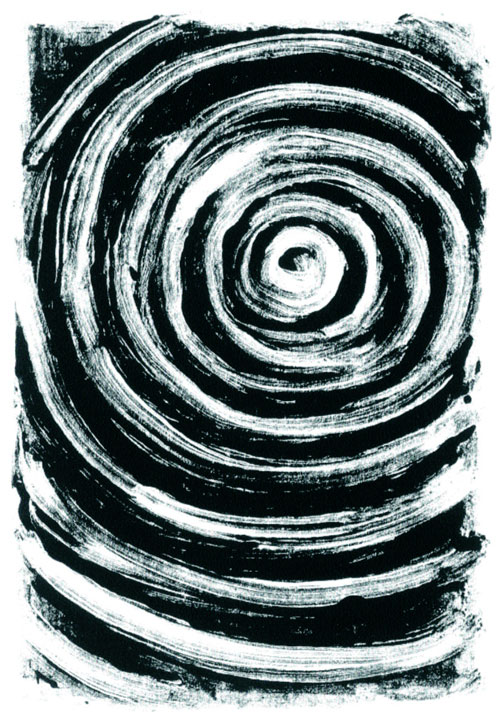
Night into Day into Night © Jan Richardson
It’s good to be back in the Sanctuary after a while away! I’ve recently wrapped up a wonderful but intense stretch of events and travels and am enjoying settling back into a more normal rhythm of life—as normal as it ever gets around here—and hunkering down to work on some creative projects that I’ve been itching to get to. This includes a return to the Sanctuary of Women blog. With the season of Lent just around the corner, this seems a fortuitous time to reenter the Sanctuary and spend time with you here.
As I prepare for the season ahead, I have found myself revisiting some seasons past, in the form of returning to the pages of my first book, Sacred Journeys. I’ve commented here previously that In the Sanctuary of Women is something of a sequel to Sacred Journeys, which I started writing nearly twenty years ago. When I began to work on the new book, I found myself struck not only by how it spiraled me back around some of the women who appeared in my first book but especially by how it spiraled me back around the woman I was at that point in my life.
Every time we enter into a new season of the liturgical year, we are invited to do something of what I experienced as I worked on Sanctuary. The landscape we cross into may seem new to us, yet the path we walk is not linear. Even as a season draws us into unexplored territory, it prompts us to revisit and reconsider the places we have been before, and the person we were when we traveled through that season previously. A season such as Lent spirals us back around the experiences we have had, the ideas we have held, the questions we have carried. It returns us to them with different eyes, invites us to see those experiences and ideas and questions from the perspective of who we are now. It challenges us to notice what we might not have noticed the first time around and to gather up gifts that may yet linger in the landscape, tools that we can use to create the path ahead.
During Lent, as part of my own journey of reflection and return, I’m going to share some pieces from the Lenten section of Sacred Journeys. The book went out of print a few years ago—a whole other story in itself—yet there are some pieces here that I feel drawn to revisit and to offer to you. As I spiral back around these pieces, reflecting on what they may yet hold for me and what doorways they might offer for my path ahead, I invite you to ponder what parts of your own landscape the coming season might beckon you to return to, to see what wisdom and insight wait for you there.
The title of the Lenten section in Sacred Journeys is Remembering Our Wounds. It begins with this introduction:
Wisdom marks our foreheads with ashes as we leave the season after Epiphany and begin the journey through Lent. She intuits what these forty days (forty-six, including the Sundays) may hold in store for us and tries to prepare us. Remembering Jesus’ forty days in the wilderness, she knows the trials, temptations, and vulnerability one encounters in seeking to reflect, to shed, to open oneself, to prepare. She remembers the wounds that come.
As we journey through Lent, the shadow of the cross falls upon our path. All too often the church has viewed the cross of Christ as the only location of God’s saving activity. A belief that our salvation depends solely upon Christ’s death ignores God’s saving activity in Christ’s birth, life, teaching, and healing. It also risks the glorification of suffering, leading us to believe that suffering in itself brings us closer to Christ. Such a belief can make us complacent in the face of suffering, encouraging us to focus on its seeming benefits rather than healing its origins.
During Lent, Wisdom beckons us to remember the root meaning of sacrifice, which is to make holy, to make whole. Wisdom knows that the only true sacrifice is the one given freely.
In this season of reflection and repentance, we remember women whose dreams, hopes, and in many cases, lives were offered by others as unholy sacrifices toward their own ends. In these stories we encounter women whom history has dis-membered more often than re-membered. In remembering and in touching the wounds of these women, we remember and touch our own. Such remembering will lead us through painful places, yet this very remembering gives strength. The remembering itself is a sacrifice, an act of making whole.
Phyllis Trible, in her book Texts of Terror, likens the process of remembering difficult stories to Jacob’s struggle with God in Genesis 32:
To tell and hear tales of terror is to wrestle demons in the night. . . . We struggle mightily, only to be wounded. But yet we hold on, seeking a blessing: the healing of wounds and the restoration of health. If the blessing comes—and we dare not claim assurance—it does not come on our terms. Indeed, as we leave the land of terror, we limp.
And, like Jacob, we are named anew.
And so, as we return to this season, may you be blessed indeed. I look forward to having your company along the way.
[The image above is from my book In Wisdom’s Path.]
